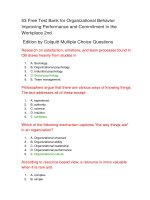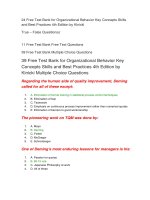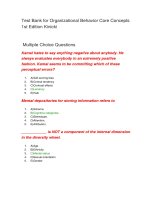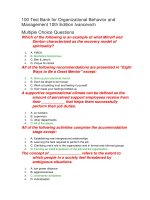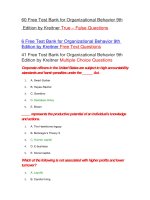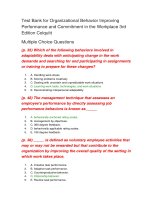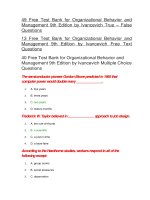97 test bank for organizational behavior core concepts 1st edition kinicki
Bạn đang xem bản rút gọn của tài liệu. Xem và tải ngay bản đầy đủ của tài liệu tại đây (114.25 KB, 23 trang )
Test Bank for Organizational Behavior Core Concepts
1st Edition Kinicki
Multiple Choice Questions
Kamal hates to say anything negative about anybody. He always evaluates
everybody in an extremely positive fashion. Kamal seems to be
committing which of these perceptual errors?
1.
A)Self-serving bias
2.
B)Central tendency
3.
C)Contrast effects
4.
D)Leniency
5.
E)Halo
Mental depositories for storing information refers to
1.
A)Schema.
2.
B)Cognitive categories.
3.
C)Stereotype.
4.
D)Attention.
5.
E)Attribution.
____________ is NOT a component of the internal dimension in the
diversity wheel.
1.
A)Age
2.
B)Ethnicity
3.
C)Marital status
4.
D)Sexual orientation
5.
E)Gender
Which of the following is NOT a common barrier to implementing
successful diversity programs?
1.
A)Inaccurate stereotypes and prejudice
2.
B)Poor career planning
3.
C)Development and accountability practices
4.
D)Ethnocentrism
5.
E)Fear of reverse discrimination
_______ are suspected or inferred causes of behavior.
1.
A)Causal attributions
2.
B)Encoding events
3.
C)Personalities
4.
D)Diversity activities
5.
E)Cognitive categories
If a student rates all his professors average on all dimensions of
performance regardless of their actual performance, he is committing
which of these perceptual errors?
1.
A)Self-serving bias
2.
B)Central tendency
3.
C)Contrast effects
4.
D)Recency effects
5.
E)Halo
It is important to remember that ______ relates to other people, ______
relates to other tasks, and ______ relates to time.
1.
A)Consensus; consistency; distinctiveness
2.
B)Distinctiveness; consistency; consensus
3.
C)Consensus; distinctiveness; consistency
4.
D)Consistency; consensus; distinctiveness
5.
E)Consistency; distinctiveness; consensus
_______ entails enabling people to perform up to their maximum potential.
1.
A)Affirmative action
2.
B)Central tendency
3.
C)Managing diversity
4.
D)Glass ceiling
5.
E)Perception
As of March 2004, women received ______ % of men's earnings.
1.
A)33
2.
B)50
3.
C)80
4.
D)94
5.
E)41
Stage 3 of the social information processing model is:
1.
A)Selective attention; comprehension
2.
B)Encoding
3.
C)Simplification
4.
D)Storage and Retention
5.
E)Retrieval and Response
_________ practices focus on preparing diverse employees for greater
responsibility and advancement.
1.
A)Recruitment
2.
B)Development
3.
C)Ethnocentric
4.
D)Accountability
5.
E)Central tendency
The final stage of the social information processing model is:
1.
A)Selective attention; comprehension
2.
B)Encoding
3.
C)Simplification
4.
D)Storage and Retention
5.
E)Retrieval and Response
Which of these represents the first stage of the social information
processing model?
1.
A)Selective attention and comprehension
2.
B)Encoding
3.
C)Simplification
4.
D)Storage and Retention
5.
E)Retrieval and Response
The ___________ represents one's tendency to take more personal
responsibility for success than for failure.
1.
A)Self-serving bias
2.
B)Glass ceiling
3.
C)Contrast effects
4.
D)Fundamental attribution bias
5.
E)Recency effect
_____ is the process of becoming consciously aware of something or
someone.
1.
A)Personality
2.
B)Attention
3.
C)Attitude
4.
D)Ethics
5.
E)Diversity
People in _______ cultures tend to think of time as ________; this is called
___________.
1.
A)North American, linear, monocronic
2.
B)Latin American, cyclic, monocronic
3.
C)Middle Eastern, cyclic, monocronic
4.
D)North American, linear, polycronic
5.
E) Middle Eastern, linear, monocronic
______ is a cognitive process that enables us to interpret and understand
our surroundings.
1.
A)Personality
2.
B)Attitude
3.
C)Perception
4.
D)Ethics
5.
E)Diversity
______ represents the multitude of individual differences and similarities
that exist among people.
1.
A)Self-serving bias
2.
B)Central tendency
3.
C)Contrast effects
4.
D)Fundamental attribution bias
5.
E)Diversity
EMU Airline has had the worst record of flight arrivals. It is always late.
However, because of the on-time or early arrival of all flights of EMU
Airlines in the last two weeks of November, Elian, the Airline Analyst of
CBA Investments rated the Airline very favorably on arrival times in his
annual report he publishes every December. Elian appears to have
committed which of these perceptual errors?
1.
A)Self-serving bias
2.
B)Central tendency
3.
C)Contrast effects
4.
D)Recency effects
5.
E)Halo
______ practices relate to managers' responsibility to treat diverse
employees fairly.
1.
A)Recruitment
2.
B)Development
3.
C)Ethnocentricity
4.
D)Accountability
5.
E)Central tendency
Women are expected to represent _____% of the labor force by 2010.
1.
A)21
2.
B)79
3.
C)66
4.
D)33
5.
E)48
___________ refers to a personal characteristic that leads an individual to
consistently evaluate other people or objects in an extremely positive
fashion.
1.
A)Leniency
2.
B)Central tendency
3.
C)Contrast effects
4.
D)Recency effects
5.
E)Halo
______ is determined by judging if the individual's performance on a given
task is consistent over time.
1.
A)Consensus
2.
B)Distinctiveness
3.
C)Schema
4.
D)Consistency
5.
E)Cognitive category
A(n) _________ is an individual's set of beliefs about the characteristics or
attributes of a group.
1.
A)Schema
2.
B)Cognitive category
3.
C)Stereotype
4.
D)Attention
5.
E)None of these.
Research identified all but one of the following strategies as critical in
breaking the glass ceiling. Which one?
1.
A)Consistently exceeding performance expectations.
2.
B)Developing a style with which male managers are comfortable.
3.
C)Seeking out difficult or challenging assignments.
4.
D)Having influential mentors.
5.
E)All of the above are critical.
In the diversity wheel, ___________ is not a component of the
organizational dimension.
1.
A)Union affiliation
2.
B)Work experience
3.
C)Management status
4.
D)Seniority
5.
E)Work location
Bryan, a store manager at Grocers R Us, tends to make more internal
attributions about worker accidents than do his workers. Bryan is
engaging in which of these?
1.
A)Self-serving bias
2.
B)Central tendency error
3.
C)Contrast effects
4.
D)Fundamental attribution bias
5.
E)Halo error
Beverly has $11,000 for investment. She speaks with various friends and
neighbors to find out what they have invested in (stocks or bonds and
which stocks). She also interviews four different investment advisors at
local brokerage companies to understand what they recommend. Beverly
can be described as being on which stage of the social information
processing model?
1.
A)Selective attention; comprehension
2.
B)Encoding
3.
C)Simplification
4.
D)Storage and Retention
5.
E)Retrieval and Response
A(n) ______ represents a person's mental picture of an event or object.
1.
A)Schema
2.
B)Cognitive category
3.
C)Stereotype
4.
D)Attention
5.
E)Attribution
Long-term memory is made up of three compartments:
1.
A)Events, semantic, and person.
2.
B)Encoding, decoding, and processing.
3.
C)Individual, group, and organization.
4.
D)Storage, retention, and response.
5.
E)Perception, personality, and attitude.
_______ memory refers to general knowledge about the world.
1.
A)Event
2.
B)Group
3.
C)Semantic
4.
D)People
5.
E)Stereotype
Which of these is (are) managerial implication(s) of perception?
1.
A)Interviewers with racist and sexist schemata can undermine the accuracy and
legality of hiring decisions.
2.
B)Faulty schemata about what constitutes good versus poor performance can lead
to inaccurate performance appraisal, which can erode work motivation,
commitment, and loyalty.
3.
C)Research demonstrates that employees' evaluations of leader effectiveness are
influenced strongly by their schemata of good and poor leaders.
4.
D)Managers need to remember that social perception is a screening process that
can distort communication, both coming and going.
5.
E)All of these.
Which of these exists at the core of diversity?
1.
A)Personality
2.
B)Perception
3.
C)Attitude
4.
D)Internal dimensions
5.
E)External dimensions
____________ belongs to the external dimensions of the diversity wheel.
1.
A)Union affiliation
2.
B)Religion
3.
C)Sexual orientation
4.
D)Ethnicity
5.
E)Seniority
A ____________ is a number of objects that are considered equivalent.
1.
A)Schema
2.
B)Category
3.
C)Stereotype
4.
D)Central tendency
5.
E)Semantic
Something is ______ when it stands out from its context.
1.
A)Schema
2.
B)Cognitive
3.
C)Salient
4.
D)Self-serving bias
5.
E)Encoded
All of the following are layers of diversity wheel except
1.
A)Personality.
2.
B)External dimensions.
3.
C)Organizational dimensions.
4.
D)External dimensions.
5.
E)Group dimensions.
Personal characteristics that are believed to cause behavior are called:
1.
A)Schematics.
2.
B)Internal factors.
3.
C)Distinctiveness.
4.
D)External factors.
5.
E)Consensus.
From 2000 to 2050, one of these groups will account for the greatest net
percentage increase in new workers in the U.S. Which one?
1.
A)Caucasians
2.
B)African-Americans
3.
C)Asian-Americans
4.
D)Asians & Hispanics
5.
E)Africa Americans & Hispanics
Connor, a production manager at XYZ Manufacturing, evaluated Darlene's
overall performance very high, every specific performance attribute.
Connor's rationale was that Darlene is the first to show up every day and
therefore she is extremely hardworking. Which of these perceptual errors
is Connor committing?
1.
A)Self-serving bias
2.
B)Central tendency
3.
C)Contrast effects
4.
D)Recency effects
5.
E)Halo
Gloria believes that she has always performed at her best at World Class
Computers. She has also received the best performance ratings from her
supervisor every year. However, she has not been promoted for the last
five years. Many of her male counterparts have been promoted. Gloria is
facing which of these?
1.
A)Self-serving bias
2.
B)Glass ceiling
3.
C)Contrast effects
4.
D)Stereotyping
5.
E)Recency effect
Francesca has had stable performance and high quality from one task to
another. This refers to:
1.
A)Low consensus.
2.
B)High distinctiveness.
3.
C)High consensus.
4.
D)Low consistency.
5.
E)Low distinctiveness.
Hilda has always had the tendency to take the credit when she meets the
deadline for her work. However when she fails, she blames the project or
other external factors. Hilda is engaging in which of these?
1.
A)Self-serving bias
2.
B)Central tendency error
3.
C)Contrast effects
4.
D)Fundamental attribution bias
5.
E)Halo error
If Judy acts like the rest of her group at work then there is:
1.
A)Low consensus.
2.
B)High distinctiveness.
3.
C)High consensus.
4.
D)Low consistency.
5.
E)High consistency.
Between 1995 and 2020, the number of individuals in the United States
over age 65 will increase by _____%.
1.
A)33
2.
B)60
3.
C)76
4.
D)94
5.
E)41
The tendency to evaluate people or object by comparing them with
characteristics of recently observed people or objects is:
1.
A)Leniency
2.
B)Central tendency
3.
C)Contrast effects
4.
D)Recency effects
5.
E)Halo
True - False Questions
In the U.S., even though people of color earn less than whites, Asians had
the highest median income.
1.
True
2.
False
Diversity is primarily an issue of race, age, and gender.
1.
True
2.
False
Accountability practices in managing diversity focus on preparing diverse
employees for greater responsibility and advancement.
1.
True
2.
False
When an object stands out from its context, it is salient.
1.
True
2.
False
Perception is the innermost layer of diversity because it represents a
stable set of characteristics that is responsible for a person's identity.
1.
True
2.
False
The tendency to avoid all extreme judgments and rate people average or
neutral is the perceptual error called leniency.
1.
True
2.
False
Semantic memory refers to the general knowledge about the world.
1.
True
2.
False
Stereotyping begins by categorizing people into groups according to
various criteria.
1.
True
2.
False
A stereotype is a mental picture of an event or object.
1.
True
2.
False
Managers tend to disproportionately attribute behaviors to internal
causes.
1.
True
2.
False
Research reveals that individuals can be trained to be more accurate
raters of performance.
1.
True
2.
False
Women constituted 46% of the labor force in 1996 and are expected to
represent 67% by 2010.
1.
True
2.
False
According to research on performance appraisal, managers should use
more subjectively-based measures of performance as much as possible
because objective measures are prone to bias and inaccuracy.
1.
True
2.
False
According to Kelley, a person is exhibiting high distinctiveness when he;
she acts like the rest of the group.
1.
True
2.
False
Religion is one of the primary dimensions of diversity.
1.
True
2.
False
Unfortunately, stereotypes are always negative.
1.
True
2.
False
Affirmative action focuses on achieving equality of opportunity in an
organization and is legally mandated in the United States by the Equal
Opportunity laws.
1.
True
2.
False
It is important to remember that in attribution theory, consensus relates to
other tasks, consistency relates to other people, and distinctiveness
relates to time.
1.
True
2.
False
Unstable performance of a given task over time, according to Kelley,
would mean low consistency.
1.
True
2.
False
“Encoding and simplification” is the first stage of the social information
processing model.
1.
True
2.
False
The first stage of the social information processing model describes how
specific information is observed and stored in the memory, and the last
three stages involve turning mental representation into real-world
judgments and decisions.
1.
True
2.
False
The U.S. Census Bureau predicts that minority groups will constitute
almost 50% of the U.S. population by 2050.
1.
True
2.
False
True - False Questions
In the U.S., even though people of color earn less than whites, Asians had
the highest median income.
1.
True
2.
False
Diversity is primarily an issue of race, age, and gender.
1.
True
2.
False
Accountability practices in managing diversity focus on preparing diverse
employees for greater responsibility and advancement.
1.
True
2.
False
When an object stands out from its context, it is salient.
1.
True
2.
False
Perception is the innermost layer of diversity because it represents a
stable set of characteristics that is responsible for a person's identity.
1.
True
2.
False
The tendency to avoid all extreme judgments and rate people average or
neutral is the perceptual error called leniency.
1.
True
2.
False
Semantic memory refers to the general knowledge about the world.
1.
True
2.
False
Stereotyping begins by categorizing people into groups according to
various criteria.
1.
True
2.
False
A stereotype is a mental picture of an event or object.
1.
True
2.
False
Managers tend to disproportionately attribute behaviors to internal
causes.
1.
True
2.
False
Research reveals that individuals can be trained to be more accurate
raters of performance.
1.
True
2.
False
Women constituted 46% of the labor force in 1996 and are expected to
represent 67% by 2010.
1.
True
2.
False
According to research on performance appraisal, managers should use
more subjectively-based measures of performance as much as possible
because objective measures are prone to bias and inaccuracy.
1.
True
2.
False
According to Kelley, a person is exhibiting high distinctiveness when he;
she acts like the rest of the group.
1.
True
2.
False
Religion is one of the primary dimensions of diversity.
1.
True
2.
False
Unfortunately, stereotypes are always negative.
1.
True
2.
False
Affirmative action focuses on achieving equality of opportunity in an
organization and is legally mandated in the United States by the Equal
Opportunity laws.
1.
True
2.
False
It is important to remember that in attribution theory, consensus relates to
other tasks, consistency relates to other people, and distinctiveness
relates to time.
1.
True
2.
False
Unstable performance of a given task over time, according to Kelley,
would mean low consistency.
1.
True
2.
False
“Encoding and simplification” is the first stage of the social information
processing model.
1.
True
2.
False
The first stage of the social information processing model describes how
specific information is observed and stored in the memory, and the last
three stages involve turning mental representation into real-world
judgments and decisions.
1.
True
2.
False
The U.S. Census Bureau predicts that minority groups will constitute
almost 50% of the U.S. population by 2050.
1.
True
2.
False
Free Text Questions
Describe in detail the managerial implications of perception in any two
areas. Give an example of each.
Answer Given
A wide variety of managerial activities are affected by perception. The text talks
about the following four: hiring, performance appraisal, leadership, communication
and interpersonal influence, physical and psychological well-being and designing
web pages.
Briefly describe the four stages of the social information processing
model.
Answer Given
Selective attention; comprehension; encoding and simplification; storage and
retention; and retrieval and response.
Briefly describe Kelley's model of attribution. Using an example, explain
how attributions can be made internally or externally and what impact it
may have on the employees and organizations.
Answer Given
Students should address the three dimensions: consensus, distinctiveness, and
consistency. Managerial implications of attributions are discussed in the text.
Define “glass ceiling”. What strategies can be employed by women to
break the glass ceiling? A#Glass ceiling refers to the invisible barrier
blocking women and minorities from top management positions. At least
four strategies have been identified by research that are critical in
breaking the glass ceiling for women: consistently exceeding
performance expectations, developing a style with which male managers
are comfortable, seeking out difficult or challenging assignments, and
having influential mentors.
Answer Given
Discuss the commonly found perceptual errors. Define each error and
provide an example.
Answer Given
Commonly found perceptual errors are halo, leniency, central tendency, recency,
and contrast.
Briefly explain the four layers of diversity. Identify at least four
components of any two layers.
Answer Given
The four layers of diversity are personality, internal dimensions, external
dimensions, and organizational dimensions.
Identify and briefly describe the common barriers to implementing
successful diversity programs.
Answer Given
The common barriers to implementing successful diversity programs include: 1)
inaccurate stereotype and prejudice, 2) ethnocentrism, 3) poor career planning, 4)
an unsupportive and hostile environment for diverse employees, 5) lack of political
savvy on part of the diverse employees, 6) difficulty in balancing career and family
issues, 7) fears of reverse discrimination, 8) diversity is not seen as an
organizational priority, 9) the need to revamp the organization's performance
appraisal and reward system, and 10) resistance to change.

